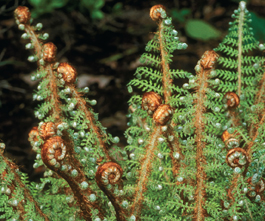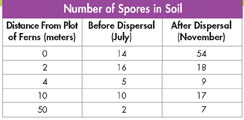Seedless Vascular Plants Although the tracheophytes include all seed-bearing plants, vascular tissue is also found in many groups of plants that do not produce seeds. Among the seedless vascular plants alive today are three phyla commonly known as club mosses, horsetails, and ferns.  DOL•23
DOL•23
The most numerous seedless plants are the ferns. More than 11,000 species of ferns are living today. Ferns have true vascular tissues, strong roots, creeping or underground stems called rhizomes (RY zohmz), and large leaves called fronds, shown in Figure 22–13. Ferns can thrive in areas with little light. They are most abundant in wet, or at least seasonally wet, habitats.
Life Cycle The large plants we recognize as ferns are actually diploid sporophytes. The fern life cycle is shown in Figure 22–14. Ferns and other vascular plants have a life cycle in which the diploid sporophyte is the dominant stage.
In the fern life cycle, spores grow into thin, heart-shaped haploid gametophytes. Although it is tiny, the gametophyte grows independently of the sporophyte. As in bryophytes, sperm and eggs are produced on these gametophytes in antheridia and archegonia, respectively.
Fertilization requires at least a thin film of water, so that the sperm can swim to the eggs. The diploid zygote produced by fertilization immediately begins to develop into a new sporophyte plant. As the sporophyte matures, haploid spores develop on the undersides of the fronds in sporangia, and the cycle begins again.

FIGURE 22–13 Structure of a Fern Ferns are easily recognized because of their delicate leaves, called fronds. Before a frond unfurls, it is called a fiddlehead.
Analyzing Data
Keeping Ferns in Check
Dennstaedtia punctilobula is a fern that grows on the forest floor and often crowds out tree seedlings, blocking efforts to regrow trees after logging or other work in a forest. To understand the fern better, scientists measured the number of viable fern spores per square centimeter of soil at various distances from a plot of existing fern plants. They counted spores in the soil in July, as the ferns were just beginning to grow; and in November, after they had released their spores.
Graph Place the data from the table on a line graph showing the number of spores per square centimeter versus their distance from the plot. Use different colors for the before and after dispersal data points.
Calculate What percentage of the spores after dispersal are found within 4 meters of the parent plants?

Interpret Graphs Are spore numbers higher before dispersal or after dispersal? Explain.
Draw Conclusions Would cutting down nearby clusters of ferns prevent ferns from invading patches of the forest that have just been cut for timber? Explain your reasoning on the basis of the data.

Table of Contents
- Formulas and Equations
- Applying Formulas and Equations
- Mean, Median, and Mode
- Estimation
- Using Measurements in Calculations
- Effects of Measurement Errors
- Accuracy
- Precision
- Comparing Accuracy and Precision
- Significant Figures
- Calculating With Significant Figures
- Scientific Notation
- Calculating With Scientific Notation
- Dimensional Analysis
- Applying Dimensional Analysis





